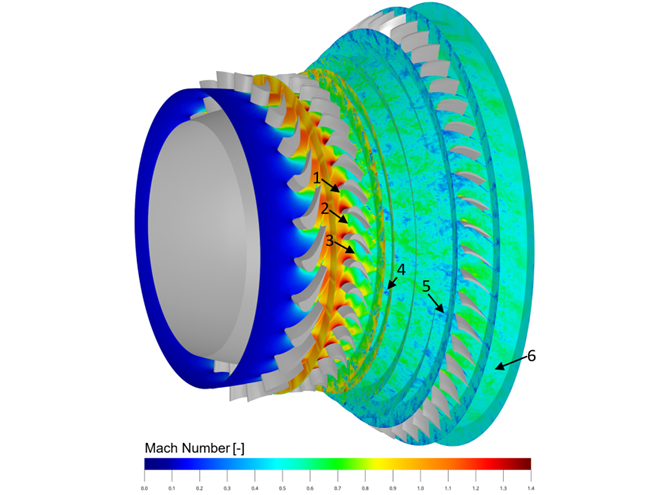Techsburg and Solar Turbines to present paper at 2025 ASME IGTI Turbo Expo June 16-20 in Memphis, TN entitled "Evaluation of Lattice-Boltzmann Method Simulations for a 1-1/2 Stage Transonic Turbine with an Aggressive Interturbine Transition Duct"

The predictive accuracy of the lattice-Boltzmann method very large eddy simulation (LBM-VLES) approach was evaluated for a 1-1/2 stage transonic turbine with an aggressive interturbine transition duct (ITD). As the geometry was not publicly available, efforts were undertaken to reverse engineer the geometry of the transonic high pressure turbine (HPT) and the low pressure (LP) vane of the Transonic Test Turbine rig at the Institute for Thermal Turbomachinery at Graz University of Technology in Styria, Austria in its single HP stage aero design point (ADP1), aggressive ITD (C4) configuration. The reverse engineering process was guided by conducting steady Reynolds-Averaged Navier-Stokes (RANS) simulations using the ANSYS CFX® solver with the goal of matching published bulk performance metrics and radial flow distributions for this rig.
The unsteady LBM-VLES simulation approach (implemented using the commercial PowerFLOW®: solver developed by Dassault Systèmes Simulia Corp.) involved documenting the sensitivity of calculated bulk performance to the grid resolution, with the cell count varying from 245 million to 1.2 billion voxels (Cartesian grid elements). Particular attention was paid to grid refinement within the tip gap of the unshrouded HP blades and the evolution of resolved turbulence along the ITD shroud as the tip leakage vortices propagated downstream. Two different HP blade tip gaps were simulated (1.5% and 2.4% of the blade span), and the sensitivity to the varying tip gap was evaluated in terms of flow field evolution through the ITD and downstream LP vane row, with comparisons against RANS simulations and published rig test data. LBM-VLES simulations also identified the occurrence of an HP vane wake/blade interaction-based secondary flow mechanism, and simulation results related to this secondary flow mechanism agreed with prior experimental observations and measurements through the ITD and LP vane exit plane.
Overall, the authors found that LBM-VLES simulations were a suitable approach for predicting the performance and unsteady loss mechanisms of a 1-1/2 stage transonic turbine coupled to an aggressive ITD, at a computational cost compatible with industrial design cycles. To the authors’ knowledge, this publication represents a novel application of the lattice-Boltzmann method, in terms of both the transonic operating regime of the HP stage and its coupling to an aggressive ITD.
